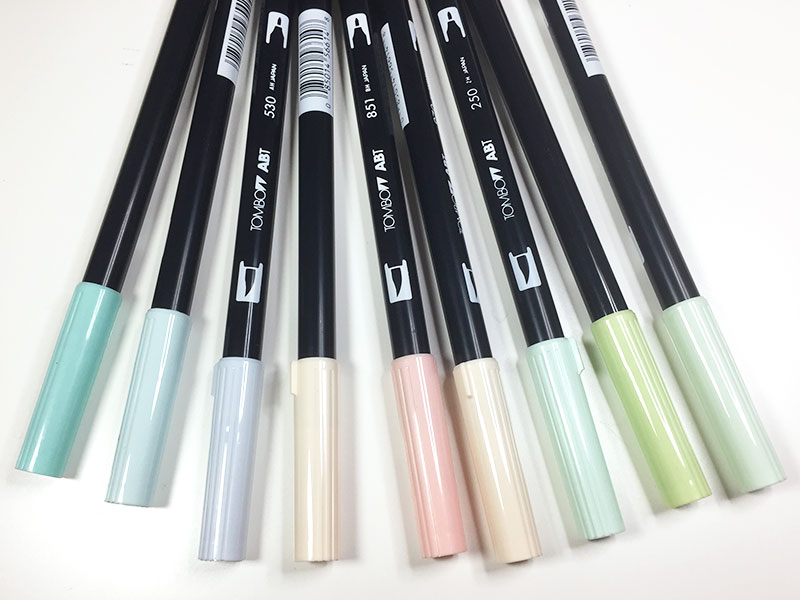
The Tombow brand has been around since it was founded in 1927. The parent company celebrated it‘s 100th Anniversary in 2013.
They began with the production of pencils and sharpeners and manufactured those for over 20 years. The production of felt-tip and ball-point pens began in 1958, and the solvent-free Tombow marker in 1974. The ABT Dual Brush Pen, originally in 72 colors was launched in 1984.
I‘ve been using Tombow Dual Brush Pens for as long as the company has been making them. I have some markers that are over 20 years old, and they still work. Because some of my original markers were lost or damaged, I finally purchased a new 96-color set early last year (2016) from Amazon .
I do not have the container these pens came in. It was a cardboard box and the pens were in a plastic bag inside. I had the box sitting on its side for a while with the markers stacked horizontally in it, but it really didn‘t work very well. If you pulled out a marker, others would shift and fill in the space, making it hard to put the one you pulled out back in.
The set come with a “rack”, which I don‘t find particularly useful.

It is designed to hold the pens upright. I choose to store my pens horizontally.

The pen body is black with white imprinting. It is just under 7-1/" long when both covers are on.

It is 7″ without either cover.

The 452 marker is from the new set. The 351 marker I have had for years, it is a color no longer made. Notice the difference in the writing on the two markers. The new markers have the new logo, designed for the company‘s 100th anniversary, that looks like a dragonfly.
The cover on the brush end is 2″ long and colored to coordinate with the color of the ink in the marker. It also has a raised line that is designed to keep the pen from rolling around. When you take the cover off, it will fit over the nib end/cover very nicely, as you can see below.

The cover on the nib end is 7/8″ long and black. The cowl on the nib end is also color coordinated with the ink in the pen. When the cover is on this end, you can still see a ring of color. When you remove the nib cover, it fits inside the cover to the brush end, to keep it from getting lost, or confused with the cover from a different colored pen.

Both caps “click” into place so you will know that the pen is completely closed. I always appreciate this feature because it helps to keep the pens from drying out.

The porous brush tip has some flexibility, and allows you to make a variety of line sizes. It‘s very popular with artists who do brush lettering. The small nib doesn‘t make quite a fine a line as the Tim Holtz® Distress Markers, but it‘s not bad.
The markers are nice and juicy, so the test marker worked well for all of the watercolor tests. I did notice that in the On Wet test, the marker sort of repelled the water, and the color puddled around the droplet, rather than mixing in.

_Note: Substrate used for testing examples is Strathmore Vellum finish Bristol board.
Keep in mind that these pens are not fade proof. That means that they are fine if you don‘t expect the art they are used on to be viable 100 years from now. If you choose to use them, I recommend you store the art piece in a book or portfolio away from light except when being viewed. They are acid free, meaning they will not affect the paper over time.
I find that the brush tip can scrape up the surface coating on some papers. I wish it was a little smoother so that this didn‘t happen. I also don‘t recommend working into a wet area, as this seems to make the surface damage worse.
One of the 96 available colors is actually a colorless blender pen. While I know people who like it, I don‘t. It suffers from the same problem as the inked brushes: it tears up the surface of many paper types. I find it also dries out quickly. So I prefer to use a damp water brush for blending, smoothing and fading.
These pens used to be available in 144 different colors. I have a few left from that time, as you saw above. Although my new set didn‘t have as many colors, I don‘t find myself missing the discontinued ones. They were mostly pastel versions, and I can get that tonal value by adding water.
You can add water to a dried out marker, or re-ink them if necessary. I used a pair of Copic nib tweezers to pull the nib out of the end of the one below.

Make sure you grab the nib at the base, so you don‘t damage the brush shape.

Unlike the Distress markers, you cannot get the ink resivoir out of the Tombow pens without damaging the pen itself, so you will have to, carefully, add the ink/water by dropping it into the space where the brush nib goes.
Tombow doesn‘t make ink for these pens, so you will have to mix your own matching colors from other brands.
As I said at the beginning, I‘ve been using these pens for many, many years. I‘m sure I will continue using them on a regular basis. The range of colors is very good, they are well made, and the price is reasonable.
- Tombow Dual Brush Pen Set - 96 colors - $279.99 suggested retail
- Target - not available on website
- Walmart - $117.23
- Amazon - $117.29
- Dick Blick - $133.82
- Jerry‘s Artarama - $164. 69